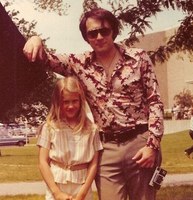
Plan your visit
Our (FREE) parking lot is located on New York Street a ½ block east of West Street. Free parking with admission.
How Instagram Changes the Photo Dating Game
August 29, 2012

I came across this photo on a friend’s Facebook page. It’s a recent shot of her son posing by a 1970s car. She used Instagram’s 1977 filter on it. Looks cool, doesn’t it? But 50 years from now, what date would a photo expert assign to it?
A little background: Instagram is a photo-sharing program and a social network that allows you to
take a photo on your mobile device, apply one of 18 filters if you choose and share it with the option of also sharing it on your Facebook and Twitter accounts. Instagrammers follow people and have followers, similar to Twitter. It has been around for about two years, but has exploded in popularity. More than 30 million people were using this little app at the beginning
of this year, and now they are uploading 58 photos per second. If you’re on Facebook, I bet you see several of these square photos every time you log in, whether your friends are over-sharers or not.
Back to the question: How does all this new technology affect how we’ll look at photos in years to come? I asked Susan Sutton, IHS’s coordinator of visual reference services (that’s our fancy way of saying she’s our go-to photo expert). “Dating photographs can be a lot of fun, but there are some pitfalls, and I
think we won?t know the full effects of the digital age for several
years,” she says. David Turk, manager of preservation imaging services, agrees. “Even before Instagram, the advance of digital manipulations pretty much
changed the way photos are looked at,” he says. “Unless you have a physical copy
in your hands, dating digital images may be impossible.”
What do historians look for when dating photos, and specifically what would they see in this one? “Every photograph offers different challenges and clues,” says Susan. “My eye went first to the car visible behind the guy, but he is actually the key element in the photograph. When looking at old images including cars, you can certainly come up with a starting point by dating the car for example, if the car is an early 1920s model, the image is not from any earlier but some people keep cars a long time, so you have to try to read license plates, look at signs and look at the clothing of the people in the image. Sometimes dating the clothing doesn’t even work because a lot of older people don?t necessarily dress with the trends. We also look at recognizable buildings. The use of a photographic process can help narrow things down if you have the original in your hand.”

These processes are actually nothing new, though. For many years, photographers have been using filters and techniques that could make an image look older than it is at first glance. Susan says she has a photo in her office that people often think is from the IHS collection, but it?s one her and her husband shot in the mid-1980s. “There are a lot of things people can do with Photoshop that blow my mind some of them for fun and some deliberately to deceive,” she says. “I would never just presume to give a date without seeing the original print or knowing that the scan I am seeing is directly from the original.”
So without a reliable date on a digital file and noting that some files on my MacBook Pro are mysteriously dated Jan. 1, 1909 would the paper an image is printed on give us a clue? Susan Rogers, our paper conservator, says yes. “There are huge differences in papers from the 1970s versus today – even from year to year with digital papers, ” she says. “And those can be detected if you have the right equipment.”
So go ahead and have your fun. We’ll be ready for it.
___________________








